HP 345 G2, 340 G1, 248 G1 Maintenance and Service Guide

HP 345 G2 Notebook PC,
HP 340 G1 Notebook PC
(in Latin America and the United States), and HP 248 G1 Notebook PC
(in India, Taiwan, and Thailand)
Maintenance and Service Guide
© Copyright 2014 Hewlett-Packard
Development Company, L.P.
AMD, the AMD Arrow logo, and combinations thereof, are trademarks of Advanced Micro Devices, Inc. Bluetooth is a trademark owned by its proprietor and used by Hewlett-Packard Company under license. Intel, Core, Pentium, and Celeron are trademarks of Intel Corporation in the U.S. and other countries. Microsoft and Windows are U.S. registered trademarks of Microsoft Corporation. SD Logo is a trademark of its proprietor.
The information contained herein is subject to change without notice. The only warranties for HP products and services are set forth in the express warranty statements accompanying such products and services. Nothing herein should be construed as constituting an additional warranty. HP shall not be liable for technical or editorial errors or omissions contained herein.
First Edition: June 2014
Second Edition: November 2013
Document Part Number: 743696-002
Product notice
This guide describes features that are common to most models. Some features may not be available on your computer.
Not all features are available in all editions of Windows 8. This computer may require upgraded and/or separately purchased hardware, drivers, and/or software to take full advantage of Windows 8 functionality. See for http://www.microsoft.com details.
Software terms
By installing, copying, downloading, or otherwise using any software product preinstalled on this computer, you agree to be bound by the terms of the HP End User License Agreement (EULA). If you do not accept these license terms, your sole remedy is to return the entire unused product (hardware and software) within 14 days for a refund subject to the refund policy of your place of purchase.
For any further information or to request a full refund of the computer, please contact your local point of sale (the seller).

Safety warning notice
WARNING! To reduce the possibility of heat-related injuries or of overheating the device, do not place the device directly on your lap or obstruct the device air vents. Use the device only on a hard, flat surface. Do not allow another hard surface, such as an adjoining optional printer, or a soft surface, such as pillows or rugs or clothing, to block airflow. Also, do not allow the AC adapter to contact
the skin or a soft surface, such as pillows or rugs or clothing, during operation. The device and the AC adapter comply with the user-accessible surface temperature limits defined by the International Standard for Safety of Information Technology Equipment (IEC 60950).
iii
iv Safety warning notice

Table of contents
1 |
Product description ........................................................................................................... |
1 |
|
Product Name ......................................................................................................................... |
1 |
|
Chipset ................................................................................................................................... |
1 |
|
Processor ................................................................................................................................ |
2 |
|
Panel ...................................................................................................................................... |
2 |
|
Graphics ................................................................................................................................. |
3 |
|
Memory .................................................................................................................................. |
4 |
|
Flash cache ............................................................................................................................. |
4 |
|
MiniCard solid-state drive ......................................................................................................... |
5 |
|
Primary storage ....................................................................................................................... |
5 |
|
Audio and video ...................................................................................................................... |
6 |
|
Optical drive ........................................................................................................................... |
6 |
|
Ethernet .................................................................................................................................. |
6 |
|
Wireless networking ................................................................................................................. |
7 |
|
External expansion ................................................................................................................... |
7 |
|
Ports ....................................................................................................................................... |
8 |
|
Keyboard/pointing devices ....................................................................................................... |
8 |
|
Power requirements .................................................................................................................. |
9 |
|
Security .................................................................................................................................. |
9 |
|
Operating system ................................................................................................................... |
10 |
|
Serviceability ......................................................................................................................... |
11 |
2 |
External component identification ................................................................................... |
12 |
|
Display ................................................................................................................................. |
12 |
|
Buttons, speakers, and fingerprint reader (select models only) ...................................................... |
13 |
|
Keys ..................................................................................................................................... |
14 |
|
Lights .................................................................................................................................... |
15 |
|
TouchPad .............................................................................................................................. |
16 |
|
Front ..................................................................................................................................... |
17 |
|
Left side ................................................................................................................................ |
18 |
|
Right side .............................................................................................................................. |
19 |
v
|
Bottom .................................................................................................................................. |
20 |
3 |
Illustrated parts catalog .................................................................................................. |
21 |
|
Locating the serial number, product number, and model number .................................................. |
21 |
|
Computer major components ................................................................................................... |
22 |
|
Display assembly components ................................................................................................. |
32 |
|
Plastics Kit ............................................................................................................................. |
33 |
|
Mass storage devices ............................................................................................................. |
34 |
|
Miscellaneous parts ................................................................................................................ |
35 |
|
Sequential part number listing .................................................................................................. |
37 |
4 |
Removal and replacement preliminary requirements ...................................................... |
47 |
|
Tools required ....................................................................................................................... |
47 |
|
Service considerations ............................................................................................................ |
47 |
|
Plastic parts ............................................................................................................ |
47 |
|
Cables and connectors ............................................................................................ |
48 |
|
Drive handling ........................................................................................................ |
48 |
|
Grounding guidelines ............................................................................................................. |
49 |
|
Electrostatic discharge damage ................................................................................. |
49 |
|
Packaging and transporting guidelines ....................................................... |
50 |
|
Workstation guidelines .............................................................. |
50 |
5 |
Removal and replacement procedures for Customer Self-Repair parts ............................. |
52 |
|
Component replacement procedures ........................................................................................ |
52 |
|
Battery ................................................................................................................... |
53 |
|
Service cover .......................................................................................................... |
54 |
|
Hard drive ............................................................................................................. |
55 |
|
WLAN module ........................................................................................................ |
58 |
|
Solid-state drive ...................................................................................................... |
60 |
|
Memory module ...................................................................................................... |
62 |
|
Optical drive .......................................................................................................... |
64 |
|
Keyboard ............................................................................................................... |
66 |
6 |
Removal and replacement procedures for Authorized Service Provider parts .................. |
69 |
|
Component replacement procedures ........................................................................................ |
69 |
|
Top cover ............................................................................................................... |
69 |
|
Fingerprint reader module ........................................................................................ |
73 |
|
TouchPad button board ............................................................................................ |
74 |
|
Card reader board .................................................................................................. |
76 |
|
Power button board ................................................................................................. |
77 |
vi
Speakers ................................................................................................................ |
78 |
Audio/USB board ................................................................................................... |
80 |
System board ....................................................................................................... |
0 |
Heat sink ............................................................................................................. |
0 |
Fan ..................................................................................................................... |
0 |
RTC battery .......................................................................................................... |
0 |
Power connector cable .......................................................................................... |
0 |
Display assembly .................................................................................................. |
0 |
7 Computer Setup (BIOS) ................................................................................................. |
0 |
Windows 8 – Computer Setup (BIOS), MultiBoot, and HP PC Hardware Diagnostics (UEFI) .......... |
0 |
Using Computer Setup ........................................................................................... |
0 |
Starting Computer Setup ......................................................................... |
0 |
Navigating and selecting in Computer Setup ............................................. |
0 |
Restoring factory settings in Computer Setup .............................................. |
0 |
Updating the BIOS ................................................................................. |
0 |
Determining a BIOS version ...................................................... |
0 |
Downloading a BIOS update .................................................... |
0 |
Using MultiBoot .................................................................................................... |
0 |
About the boot device order .................................................................... |
0 |
Choosing MultiBoot preferences ............................................................... |
0 |
Setting a new boot order in Computer Setup .............................. |
0 |
Dynamically choosing a boot device using the f9 prompt ............. |
0 |
Setting a MultiBoot Express prompt ........................................... |
0 |
Entering MultiBoot Express preferences ...................................... |
0 |
Using HP PC Hardware Diagnostics (UEFI) (select models only) ................................... |
0 |
Downloading HP PC Hardware Diagnostics (UEFI) to a USB device .............. |
0 |
Windows 7 – Computer Setup (BIOS), MultiBoot, and HP PC Hardware Diagnostics (UEFI) .......... |
0 |
Using Computer Setup ........................................................................................... |
0 |
Starting Computer Setup ......................................................................... |
0 |
Navigating and selecting in Computer Setup ............................................. |
0 |
Restoring factory settings in Computer Setup .............................................. |
0 |
Updating the BIOS ................................................................................. |
0 |
Determining a BIOS version ...................................................... |
0 |
Downloading a BIOS update for Windows 7 ............................. |
0 |
Using MultiBoot .................................................................................................... |
0 |
About the boot device order .................................................................... |
0 |
Choosing MultiBoot preferences ............................................................... |
0 |
Setting a new boot order in Computer Setup .............................. |
0 |
Dynamically choosing a boot device using the f9 prompt ............. |
0 |
Setting a MultiBoot Express prompt ........................................... |
0 |
vii
|
Entering MultiBoot Express preferences ...................................... |
120 |
|
Using HP PC Hardware Diagnostics (UEFI) (select models only) ................................... |
121 |
|
Downloading HP PC Hardware Diagnostics (UEFI) to a USB device .............. |
121 |
|
Linux – Computer Setup (BIOS) and Advanced System Diagnostics ............................................. |
122 |
|
Starting Computer Setup ........................................................................................ |
122 |
|
Using Computer Setup ........................................................................................... |
122 |
|
Navigating and selecting in Computer Setup ............................................. |
122 |
|
Restoring factory settings in Computer Setup .............................................. |
123 |
|
Updating the BIOS ................................................................................................ |
124 |
|
Determining the BIOS version .................................................................. |
124 |
|
Downloading a BIOS update ................................................................... |
124 |
|
Using Advanced System Diagnostics ....................................................................... |
125 |
8 |
Specifications ................................................................................................................ |
126 |
9 Backup and recovery .................................................................................................... |
127 |
|
|
Windows 8 ......................................................................................................................... |
127 |
|
Backing up your information ................................................................................... |
127 |
|
Performing a system recovery ................................................................................. |
128 |
|
Using the Windows recovery tools ........................................................... |
129 |
|
Using f11 recovery tools ......................................................................... |
130 |
|
Using Windows operating system media (purchased separately) .................. |
130 |
|
Using Windows Refresh or Windows Reset ............................................... |
131 |
|
Using HP Software Setup ........................................................................ |
131 |
|
Windows 7 ......................................................................................................................... |
132 |
|
Creating recovery media with HP Recovery Disc Creator ............................................ |
133 |
|
Creating recovery media ......................................................................... |
133 |
|
Backing up your information ................................................................................... |
133 |
|
Performing a system recovery ................................................................................. |
134 |
|
Using the Windows recovery tools ........................................................... |
135 |
|
Using f11 recovery tools ......................................................................... |
136 |
|
Using a Windows 7 operating system DVD (purchased separately) .............. |
137 |
|
Linux .................................................................................................................................. |
138 |
|
Creating backups .................................................................................................. |
138 |
|
Backing up your information ................................................................................... |
138 |
|
Performing a system recovery ................................................................................. |
139 |
|
Remove everything and reinstall SLED ...................................................................... |
140 |
10 |
Statement of Volatility ................................................................................................ |
141 |
|
Non-volatile memory usage ................................................................................................... |
143 |
viii
|
Questions and answers ......................................................................................................... |
146 |
11 |
Power cord set requirements ...................................................................................... |
147 |
|
Requirements for all countries ................................................................................................ |
147 |
|
Requirements for specific countries and regions ....................................................................... |
147 |
12 |
Recycling .................................................................................................................... |
149 |
Index ............................................................................................................................... |
150 |
|
ix
x

1 Product description
Product Name
Description |
HP 345 G2 Notebook PC HP 340 G1 Notebook PC and |
|
|
|
HP 248 G1 Notebook PC |
|
|
|
HP 345 G2 |
Notebook PC |
× |
|
|
|
HP 340 G1 |
Notebook PC (in Latin America and |
× |
the United States) |
|
|
|
|
|
HP 248 G1 |
Notebook PC (in India, Taiwan, |
× |
and Thailand) |
|
|
|
|
|
Chipset
Description |
HP 345 G2 Notebook PC HP 340 G1 Notebook PC and |
|
HP 248 G1 Notebook PC |
|
|
AMD® integrated soldered on circuit (SoC) fusion |
× |
controller hub (FCH) |
|
|
|
Intel® processor controller hub (PCH), SoC |
× |
|
|
Product Name |
1 |

Processor
Description |
HP 345 G2 Notebook PC HP 340 G1 Notebook PC and |
|
HP 248 G1 Notebook PC |
|
|
● AMD A8-6410 2.00-GHz (SC turbo up to 2.40- |
× |
GHz) processor (2.00-MB L2 cache, maximum |
|
DDR3L: 1600-MHz, quad core, 15 W) |
|
● AMD A6-6310 1.80-GHz (SC turbo up to 2.40- |
|
GHz) processor (2.00-MB L2 cache, maximum |
|
DDR3L: 1600-MHz, quad core, 15 W) |
|
● AMD A4-6210 1.50-GHz processor (2.00-MB L2 |
|
cache, maximum DDR3L: 1600-MHz, quad core, |
|
15 W) |
|
|
|
● Intel Core® i7-4500U 1.80-GHz processor |
× |
(dual core, 15 W) |
|
● Intel Core i5-4210U 1.70-GHz processor |
|
(dual core, 15 W) |
|
● Intel Core i5-4200U 1.60-GHz processor |
|
(dual core, 15 W) |
|
● Intel Core i3-4030U 1.90-GHz processor |
|
(dual core, 15 W) |
|
● Intel Core i3-4010U 1.70-GHz processor |
|
(dual core, 15 W) |
|
● Intel Core i3-4005U 1.70-GHz processor |
|
(dual core, 15 W) |
|
● Intel Pentium® 3556U 1.70-GHz processor |
|
(1600-MHz FSB, 2.0-MB L3 cache, 15 W) |
|
● Intel Celeron® 2980U 1.60-GHz processor |
|
(1600-MHz FSB, 2.0-MB L3 cache, 15 W) |
|
● Intel Celeron 2957U 1.40-GHz processor (1600- |
|
MHz FSB, 2.0-GB L2 cache, 15 W) |
|
|
|
Panel
Description |
HP 345 G2 Notebook PC |
HP 340 G1 Notebook PC and |
|
|
HP 248 G1 Notebook PC |
|
|
|
14.0-in, AntiGlare (AG), high-definition HD, light- |
× |
× |
emitting diode (LED), 1366×768, SVA, display panel |
|
|
with and without webcam |
|
|
|
|
|
2 |
Chapter 1 Product description |

Graphics
Description |
HP 345 G2 Notebook PC HP 340 G1 Notebook PC and |
|
HP 248 G1 Notebook PC |
|
|
Switchable discrete graphics: AMD Radeon® R5 |
× |
M240 Graphics 2-GB DDR3 with up to 2-GB of |
|
dedicated video memory (256 × 16 DDR3 @ 1-GHz, |
|
4PCs) |
|
Universal memory architecture (UMA) graphics |
|
|
|
Switchable discrete graphics: AMD Radeon™ |
× |
HD 8670M (Sun XT); 2-GB DDR3 with up to 2-GB of |
|
dedicated video memory (256 × 16 DDR3 @ 1-GHz, |
|
4PCs) or 1-GB DDR3 with up to 1-GB of dedicated |
|
video memory (128 × 16 DDR3 @ 1-GHz, 4PCs) |
|
Internal graphics – Integrated universal memory |
|
architecture (UMA) graphics: |
|
● Intel HD Graphics 4400 on computer models |
|
equipped with an Intel Core processor |
|
● Intel HD Graphics on computer models equipped |
|
with an Intel Pentium or Intel Celeron processor |
|
|
|
Graphics 3

Memory
Description |
HP 345 G2 Notebook PC HP 340 G1 Notebook PC and |
|
HP 248 G1 Notebook PC |
|
|
Two customer-accessible/upgradable memory |
× |
module slots |
|
Support for DDR3L 1600-MHz PCL3-12800 dual |
|
channel memory |
|
Support for 8192-MB of system memory in the |
|
following configurations: |
|
● 8192-MB total system memory (8192 MB × 1; |
|
not available with 32-bit operating system) |
|
● 8192-MB total system memory (4096 MB × 2; |
|
dual channel, not available with 32-bit |
|
operating system) |
|
● 4096-MB total system memory (4096 MB × 1) |
|
|
|
Two customer-accessible/upgradable memory |
× |
module slots |
|
Support for DDR3L 1600-MHz PCL3-12800 dual |
|
channel memory |
|
Support for 16384-MB of system memory in the |
|
following configurations: |
|
● 16384-MB total system memory (8192 MB × 2; |
|
not available with 32-bit operating system) |
|
● 8192-MB total system memory (4096 MB × 2; |
|
not available with 32-bit operating system) |
|
● 4096-MB total system memory (4096 MB × 1; |
|
only memory configuration supported in Brazil) |
|
● 2048-MB total system memory (2048 MB × 1) |
|
|
|
Flash cache
Description |
HP 345 G2 Notebook PC HP 340 G1 Notebook PC and |
|
HP 248 G1 Notebook PC |
|
|
Support for 32-GB mSATA solid-state drive (not |
× |
supported on computer models equipped with the Intel |
|
i3-4005U, Intel Pentium, and Intel Celeron processor) |
|
|
|
4 |
Chapter 1 Product description |

MiniCard solid-state drive
Description |
HP 345 G2 Notebook PC HP 340 G1 Notebook PC and |
|
HP 248 G1 Notebook PC |
|
|
120-GB solid-state drive (2242/DS M.2 form factor) |
× |
Not supported if 32-GB flash cache is selected |
|
Set as primary storage if selected |
|
|
|
Primary storage
Description |
HP 345 G2 Notebook PC |
HP 340 G1 Notebook PC and |
|
|
HP 248 G1 Notebook PC |
|
|
|
Support for 6.35-cm (2.5-in) hard drives in 7.0-mm |
× |
|
(.28-in) and 9.5-mm (.37-in) thickness |
|
|
Support for Intel Smart Response Technology |
|
|
Accelerometer |
|
|
Support for hard drive protection |
|
|
|
|
|
Support for the following hard drive: |
× |
|
● 750-GB, 5400-rpm, SATA, 7.0-mm hard drive |
|
|
|
|
|
Support for 6.35-cm (2.5-in) hard drives in 7.0-mm |
|
× |
(.28-in) and 9.5-mm (.37-in) thickness |
|
|
Support for mSATA |
|
|
Support for Intel Smart Response Technology |
|
|
Accelerometer |
|
|
Support for hard drive protection |
|
|
|
|
|
Support for the following hard drives: |
|
× |
● 750-GB, 5400-rpm, SATA, 7.0-mm hard drive |
|
|
● 500-GB, 5400-rpm, SATA, 7.0-mm hard drive |
|
|
|
|
|
Support for the following hard drives: |
× |
× |
● 1-TB, 5400-rpm, SATA, 7.0-mm hard drive |
|
|
● 500-GB, 5400-rpm, SATA, 7.0-mm hard drive |
|
|
|
|
|
Support for a 32-GB mSATA solid-state drive |
|
× |
|
|
|
MiniCard solid-state drive |
5 |

Audio and video
Description |
HP 345 G2 Notebook PC |
HP 340 G1 Notebook PC and |
|
|
HP 248 G1 Notebook PC |
|
|
|
HP TrueVision HD webcam (fixed/no tilt with activity |
× |
× |
light), 1280×720 by 30 frames per second |
|
|
Support for non-webcam option |
|
|
Dual digital microphones |
|
|
Stereo speakers (2) |
|
|
DTS Sound |
|
|
|
|
|
Optical drive
Description |
HP 345 G2 Notebook PC |
HP 340 G1 Notebook PC and |
|
|
HP 248 G1 Notebook PC |
|
|
|
DVD±RW Double Layer with SuperMulti Drive |
× |
× |
9.5-mm tray load |
|
|
SATA |
|
|
Fixed (not modular) |
|
|
Support for zero-power optical drive |
|
|
Support for no optical drive option |
|
|
|
|
|
Ethernet
Description |
HP 345 G2 Notebook PC |
HP 340 G1 Notebook PC and |
|
|
HP 248 G1 Notebook PC |
|
|
|
Integrated 10/100/1000 network interface card |
× |
× |
(NIC) |
|
|
|
|
|
6 |
Chapter 1 Product description |

Wireless networking
Description |
HP 345 G2 Notebook PC |
HP 340 G1 Notebook PC and |
|
|
HP 248 G1 Notebook PC |
|
|
|
Integrated wireless local area network (WLAN) options |
× |
× |
by way of wireless module |
|
|
Two WLAN antennas built into display assembly |
|
|
|
|
|
Support for the following WLAN formats: |
× |
× |
● Atheros AR9485 802.11bgn WiFi Adapter |
|
|
● Broadcom BCM943228HMB 802.11abgn 2×2 |
|
|
Wi-Fi Adapter, Broadcom Bluetooth 4.0 Adapter |
|
|
|
|
|
Support for the following WLAN formats: |
× |
|
● Realtek RTL8723BE 802.11bgn 1×1 + Bluetooth |
|
|
4 LE Combo Adapter |
|
|
|
|
|
Support for the following WLAN formats: |
|
× |
● Ralink RT3290LE 802.11bgn 1×1 Bluetooth 4.0 |
|
|
Combo Adapter |
|
|
● Ralink RT3290LE 802.11bgn 1×1 WiFi and |
|
|
Bluetooth 4.0 Combo Adapter |
|
|
|
|
|
External expansion
Description |
HP 345 G2 Notebook PC |
HP 340 G1 Notebook PC and |
|
|
HP 248 G1 Notebook PC |
|
|
|
SD media reader slot |
× |
× |
Support for SD, SDHC, SDXC |
|
|
Push-push insertion/removal |
|
|
|
|
|
Wireless networking |
7 |

Ports
Description |
HP 345 G2 Notebook PC |
HP 340 G1 Notebook PC and |
|
|
HP 248 G1 Notebook PC |
|
|
|
● AC adapter, HP Smart (4.5-mm barrel) |
× |
× |
●Audio-in (mono microphone)/audio-out (stereo headphone) combo jack
●DisplayPort 1.2
●Docking
●RJ45 (Ethernet)
●USB 3.0 charging (1)
●USB 3.0 (2)
●VGA (Dsub 15 pin) supporting: 1920×1200 external resolution @ 75 Hz, hot plug and unplug and autodetection for correct output to wideaspect vs. standard aspect video
Keyboard/pointing devices
Description |
HP 345 G2 Notebook PC |
HP 340 G1 Notebook PC and |
|
|
HP 248 G1 Notebook PC |
|
|
|
Dual point, spill-resistant (with drain) keyboard with |
× |
× |
DuraKeys, function keys and optional |
|
|
backlightFunction Keys: |
|
|
Touchpad Requirements: Glass with chemical |
|
|
etched surface, on/off button, support for 2-way scroll, |
|
|
Taps enabled as default, Gestures enabled by default |
|
|
(2-finger scrolling, 2-finger zoom (pinch) |
|
|
|
|
|
8 |
Chapter 1 Product description |

Power requirements
Description |
HP 345 G2 Notebook PC |
HP 340 G1 Notebook PC and |
|
|
HP 248 G1 Notebook PC |
|
|
|
Support for removable 3-cell, 46-WHr, 4.15-AHr, Li- |
× |
× |
ion battery and 3-cell, 26-WHr, 2.50-AHr, Li-ion |
|
|
battery |
|
|
Support for the following AC adapters: |
|
|
●65-W HP Smart adapter (EM, RC/V, 3-wire, 4.5- mm)
●65-W HP Smart adapter (non-PFC, 3-wire, 4.5- mm)
●45-W HP Smart adapter (non-PFC, RC/V, 3-wire, 4.5-mm)
Security
Description |
HP 345 G2 Notebook PC |
HP 340 G1 Notebook PC and |
|
|
|
|
HP 248 G1 Notebook PC |
|
|
|
|
Support for the following: |
× |
× |
|
● |
Fingerprint reader |
|
|
● Full-volume encryption |
|
|
|
● Integrated Smart Card reader (active) |
|
|
|
● Preboot authentication (password, Smart Card) |
|
|
|
● |
Support Security Lock |
|
|
● Trusted Platform Module (TPM) 1.2 (Infineon;
soldered down)
● Trusted Platform Module (TPM) 1.2 (Infineon;
soldered down)
Power requirements |
9 |

Operating system
Description |
HP 345 G2 Notebook PC |
HP 340 G1 Notebook PC and |
|
|
HP 248 G1 Notebook PC |
|
|
|
Restore Media–OSDVD: |
× |
× |
●Microsoft Windows 8.1 and 8 Professional 64bit (include in Windows 8.1 and 8 downgrade operating system AV only; do not include for Asia/Pacific countries or regions or
the People's Republic of China)
●Microsoft Windows 8 64-bit (for service only)
●Microsoft Windows 8 Country Specific 64-bit (for service only)
●Microsoft Windows 8 Emerging Market 64-bit (for service only)
●Microsoft Windows 7 Home Basic 32-bit (available with any Microsoft Windows 7 Home Basic loc except for Asia/Pacific countries or regions or the People's Republic of China)
●Microsoft Windows 7 Home Premium 64and 32-bit (available with any Microsoft Windows 7 Professional or Microsoft Windows 8 downgrade loc except for Asia/Pacific countries or regions or the People's Republic of China)
●Microsoft Windows 7 Professional 64and 32-bit (available with any Microsoft Windows 7 Professional or Microsoft Windows 8 downgrade loc except for Asia/Pacific countries or regions or the People's Republic of China)
Certified:
●Microsoft WHQL
●SuSE Linux Enterprise (SLED, service pack 2, 64bit
Web-only Support:
●Microsoft Windows 8.1 Chinese market 64-bit
●Microsoft Windows 8.1 Emerging market 64-bit
●Microsoft Windows 8.1 Multi-Language 64-bit
●Microsoft Windows 8.1 Enterprise 64-bit
●Microsoft Windows 8.1 Pro 64-bit
●Microsoft Windows 7 Ultimate 64and 32-bit
●Microsoft Windows 7 Enterprise 64and 32-bit
10 Chapter 1 Product description

Serviceability
Description |
HP 345 G2 Notebook PC |
HP 340 G1 Notebook PC and |
|
|
|
|
HP 248 G1 Notebook PC |
|
|
|
|
End user replaceable parts: |
× |
× |
|
● |
AC adapter |
|
|
● |
Battery (system) |
|
|
● |
Hard drive |
|
|
● |
Keyboard |
|
|
● |
Memory module |
|
|
● Solid-state drive |
|
|
|
● |
WLAN module |
|
|
|
|
|
|
Serviceability 11
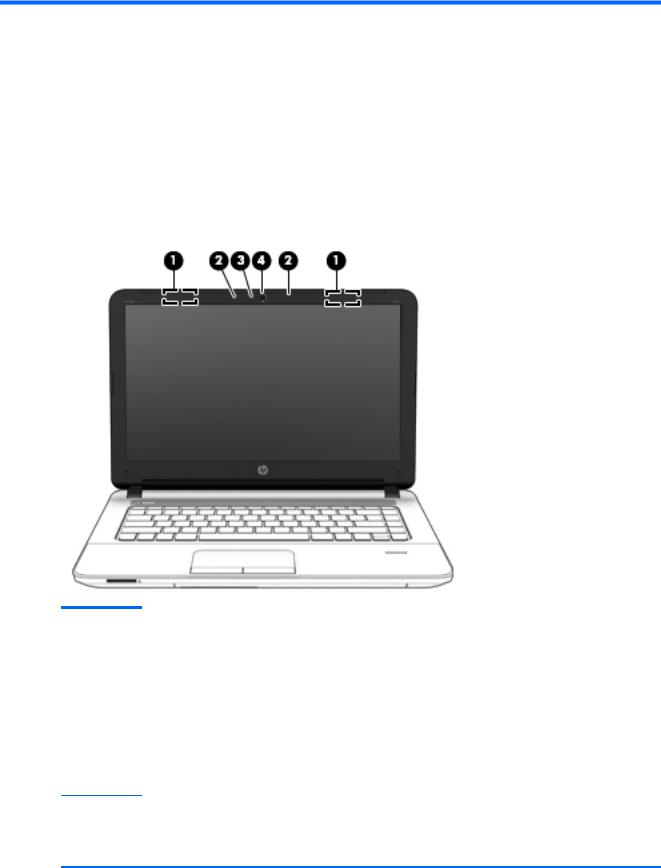
2 External component identification
Display
Item |
Component |
Description |
|
|
|
(1) |
WLAN antennas (2)* |
Send and receive wireless signals to communicate with WLANs. |
|
|
|
(2) |
Internal microphones (2) |
Record sound. |
|
|
|
(3) |
Webcam light |
On: The webcam is in use. |
|
|
|
(4) |
Webcam |
Records video and captures photographs. Some models allow you to video |
|
(select models only) |
conference and chat online using streaming video. |
For information on using the webcam, access HP Support Assistant. To access HP
Support Assistant, from the Start screen, select the HP Support Assistant app.
*The antennas are not visible from the outside of the computer. For optimal transmission, keep the areas immediately around the antennas free from obstructions. For wireless regulatory notices, see the section of the Regulatory, Safety, and Environmental Notices that applies to your country or region. To access this guide, from the Start screen, type support, and then select the HP Support Assistant app.
12 |
Chapter 2 External component identification |
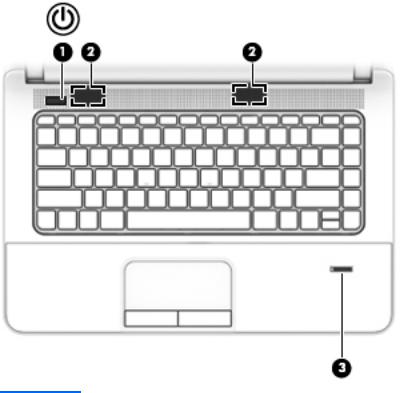
Buttons, speakers, and fingerprint reader (select models only)
Item |
Component |
Description |
|
|
|
(1) |
Power button |
● When the computer is off, press the button to turn on the computer. |
|
|
● When the computer is on, press the button briefly to initiate Sleep. |
|
|
● When the computer is in the Sleep state, press the button briefly to |
|
|
exit Sleep. |
|
|
● When the computer is in Hibernation, press the button briefly to |
|
|
exit Hibernation. |
|
|
CAUTION: CAUTION: Pressing and holding down the power button will result |
|
|
in the loss of unsaved information. |
|
|
If the computer has stopped responding and Windows shutdown procedures are |
|
|
ineffective, press and hold the power button for at least 5 seconds to turn off |
|
|
the computer. |
|
|
NOTE: For select models, the Intel Rapid Start Technology feature is enabled at |
|
|
the factory. Rapid Start Technology allows your computer to resume quickly |
|
|
from inactivity. |
|
|
To learn more about your power settings, see your power options. From the Start |
|
|
screen, type power, select Power and sleep settings, and then select |
|
|
Power and sleep from the list of applications. |
|
|
|
Buttons, speakers, and fingerprint reader (select models only) |
13 |
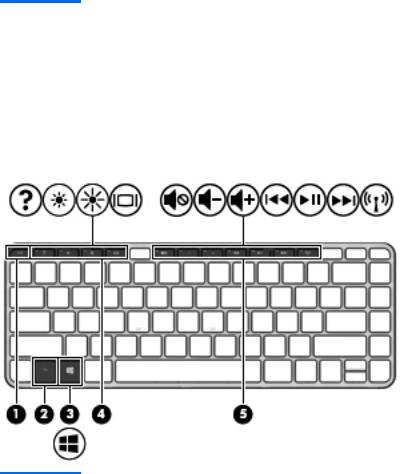
Item |
Component |
Description |
|
|
|
(2) |
Speakers |
Produce sound. |
|
|
|
(3) |
Fingerprint reader |
Allows a fingerprint logon to Windows, instead of a password logon. |
|
(select models only) |
|
|
|
|
Keys
Item |
Component |
Description |
|
|
|
(1) |
esc key |
Displays system information when pressed in combination with the fn key. |
|
|
|
(2) |
fn key |
Executes frequently used system functions when pressed in combination with a |
|
|
function key, the num lk key, the esc key, or other keys. |
|
|
|
(3) |
Windows button |
Displays the Windows Start menu. |
|
|
|
(4) |
Function keys |
Execute frequently used system functions when pressed in combination with the |
|
|
fn key. |
|
|
|
(5) |
Function keys |
Execute frequently used system functions when pressed in combination with the |
|
|
fn key. |
|
|
|
14 |
Chapter 2 External component identification |
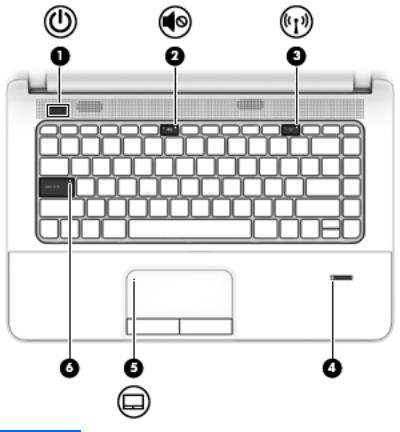
Lights
Item |
Component |
Description |
|
|
|
(1) |
Power light |
● On: The computer is on. |
|
|
● Blinking: The computer is in the Sleep state, a powersaving state. The |
|
|
computer shuts off power to the display and other unneeded components. |
|
|
● Off: The computer is off or in Hibernation. Hibernation is a power-saving |
|
|
state that uses the least amount of power. |
|
|
NOTE: For select models, the Intel Rapid Start Technology feature is enabled at |
|
|
the factory. Rapid Start Technology allows your computer to resume quickly |
|
|
from inactivity. |
|
|
|
(2) |
Mute light |
● Amber: Computer sound is off. |
|
|
● Off: Computer sound is on. |
|
|
|
(3) |
Wireless light |
On: An integrated wireless device, such as a WLAN device and/or a Bluetooth |
|
|
device, is on. |
|
|
NOTE: On some models, the wireless light is amber when all wireless devices |
|
|
are off. |
|
|
|
(4) |
Fingerprint reader (select |
Allows a fingerprint logon to Windows, instead of a password logon. |
|
models only) |
|
|
|
|
Lights 15
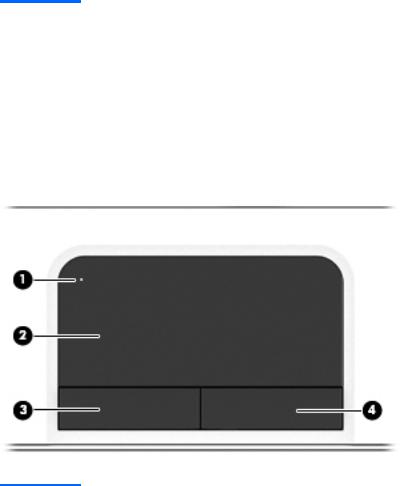
Item |
Component |
Description |
|
|
|
|
|
(5) |
TouchPad light |
● |
On: The TouchPad is off. |
|
|
● |
Off: The TouchPad is on. |
|
|
|
|
(6) |
Caps lock light |
On: Caps lock is on, which switches the keys to all capital letters. |
|
|
|
|
|
TouchPad
Item |
Component |
Description |
|
|
|
(1) |
TouchPad on/off button |
Turns the TouchPad on and off. |
|
and light |
● Amber: The TouchPad is off. |
|
|
|
|
|
● Off: The TouchPad is on. |
|
|
|
(2) |
TouchPad zone |
Moves the pointer and selects or activates items on the screen. |
|
|
|
(3) |
Left TouchPad button |
Functions like the left button on an external mouse. |
|
|
|
(4) |
Right TouchPad button |
Functions like the right button on an external mouse. |
|
|
|
16 |
Chapter 2 External component identification |
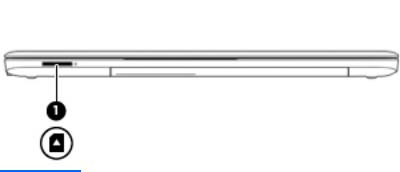
Front
Item |
Component |
Description |
|
|
|
(1) |
Memory card reader |
Reads optional memory cards that store, manage, share, or access information. |
|
|
|
Front 17
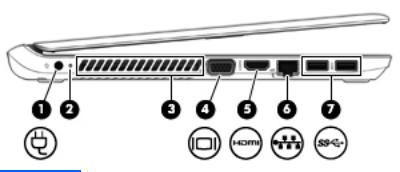
Left side
Item |
Component |
Description |
|
|
|
(1) |
Power connector |
Connects an AC adapter. |
|
|
|
(2) |
AC adapter/Battery light |
● White: The AC adapter is connected to external power and the battery is |
|
|
fully charged. |
|
|
● Amber: The AC adapter is connected to external power and the battery |
|
|
is charging. |
|
|
● Off: The AC adapter is not connected to external power. |
|
|
|
(3) |
Vent |
Enables airflow to cool internal components. |
|
|
NOTE: The computer fan starts up automatically to cool internal components |
|
|
and prevent overheating. It is normal for the internal fan to cycle on and off |
|
|
during routine operation. |
|
|
|
(4) |
External monitor port |
Connects an external VGA monitor or projector. |
|
|
|
(5) |
HDMI port |
Connects an optional video or audio device, such as a high-definition television, |
|
|
any compatible digital or audio component, or a high-speed HDMI device. |
|
|
|
(6) |
RJ-45 (network) jack |
Connects a network cable. |
|
|
● Green (left): The network is connected. |
|
|
● Amber (right): The network is showing activity. |
|
|
|
(7) |
USB 3.0 ports |
Each USB 3.0 port connects an optional USB device, such as a keyboard, mouse, |
|
|
external drive, printer, scanner or USB hub. |
|
|
|
18 |
Chapter 2 External component identification |
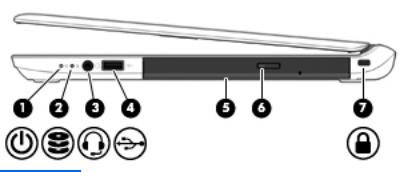
Right side
Item |
Component |
Description |
|
|
|
|
|
(1) |
Power light |
● |
On: The computer is on. |
|
|
● |
Blinking: The computer is in the Sleep state, a powersaving state. The |
|
|
|
computer shuts off power to the display and other unneeded components. |
|
|
● |
Off: The computer is off or in Hibernation. Hibernation is a power-saving |
|
|
|
state that uses the least amount of power. |
|
|
NOTE: For select models, the Intel Rapid Start Technology feature is enabled at |
|
|
|
the factory. Rapid Start Technology allows your computer to resume quickly |
|
|
|
from inactivity. |
|
|
|
|
|
(2) |
Hard drive light |
● |
Blinking white: The hard drive is being accessed. |
|
|
● |
Amber: HP 3D DriveGuard has temporarily parked the hard drive. (select |
|
|
|
models only) |
|
|
|
|
(3) |
Audio-out (headphone) |
Produces sound when connected to optional powered stereo speakers, |
|
|
jack/Audio-in |
headphones, earbuds, a headset, or television audio. Also connects an optional |
|
|
(microphone) combo jack |
headset microphone. |
|
|
|
WARNING! To reduce the risk of personal injury, adjust the volume before |
|
|
|
putting on headphones, earbuds, or a headset. For additional safety information, |
|
|
|
see the Regulatory, Safety, and Environmental Notices. |
|
|
|
NOTE: When a device is connected to the jack, the computer speakers |
|
|
|
are disabled. |
|
|
|
NOTE: Be sure that the device cable has a 4-conductor connector that supports |
|
|
|
both audio-out (headphone) and audio-in (microphone). |
|
|
|
|
|
(4) |
USB 2.0 port |
Connects an optional USB device, such as a keyboard, mouse, external drive, |
|
|
|
printer, scanner or USB hub. |
|
|
|
|
|
(5) |
Optical drive (select |
Depending on your computer model, reads an optical disc or reads and writes to |
|
|
models only) |
an optical disc. |
|
|
|
|
|
(6) |
Optical drive eject button |
Releases the optical drive disc tray. |
|
|
(select models only) |
|
|
|
|
|
|
(7) |
Security cable slot |
Attaches an optional security cable to the computer. |
|
|
|
NOTE: The security cable is designed to act as a deterrent, but it may not |
|
|
|
prevent the computer from being mishandled or stolen. |
|
|
|
|
|
Right side |
19 |
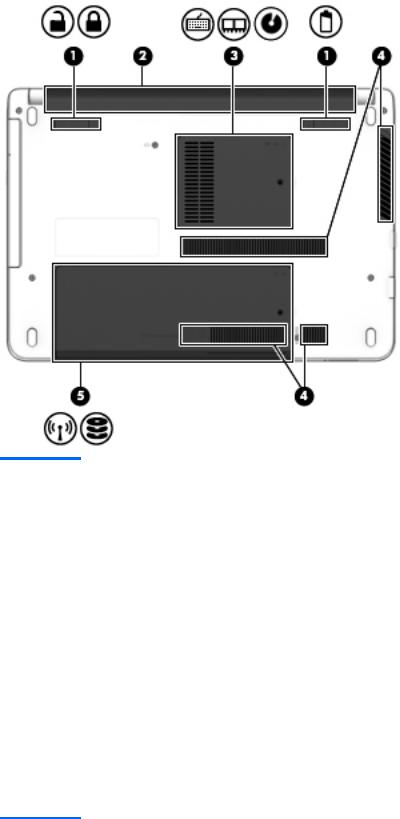
Bottom
Item |
Component |
Description |
|
|
|
(1) |
Battery cover release |
Releases the battery cover over the battery bay. |
|
latch and lock |
|
|
|
|
(2) |
Battery bay |
Holds the battery. |
|
|
|
(3) |
Memory module |
Provides access to the keyboard screw, memory module slots, and optical |
|
compartment cover |
drive screw. |
|
|
|
(4) |
Vents (2) |
Enable airflow to cool internal components. |
|
|
NOTE: The computer fan starts up automatically to cool internal components |
|
|
and prevent overheating. It is normal for the internal fan to cycle on and off |
|
|
during routine operation. |
|
|
|
(5) |
Service cover |
Provides access to the hard drive bay, the WLAN module slot, and the solid-state |
|
|
drive slot. |
CAUTION: To prevent an unresponsive system, replace the wireless module only with a wireless module authorized for use in the computer by the governmental agency that regulates wireless devices in your country or region. If you replace the module and then receive a warning message, remove the module to restore computer functionality, and then contact support through Help and Support.
20 |
Chapter 2 External component identification |
